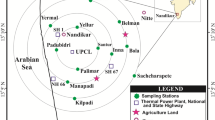Abstract
The sources of the spill and the contaminated soils of an aged oil spill contaminated site with unknown mixed pollutants were investigated by using a set of developed forensic chemical procedures which include analysis of oil products, site investigation, gas chromatography/mass spectrometry (GC/MS) screening, biomarker identification, and finally, the confirmation of pollutants. Adamantanes (17 compounds), 10 bicyclic sesquiterpanes, 6 newly detected compounds, 16 polycyclic aromatic hydrocarbons, and 10 alkylated naphthalenes compounds in several gasoline, diesel oil samples, and contaminated soil samples were examined and quantified. GC/MS method, retention indices, relative response factors, and diagnostic ratio were used to identify and quantify pollutant compounds. The study revealed the key factors for distinguishing among gasoline and diesel oil products in the market, created a new set of retention indices for 10 bicyclic sesquiterpane compounds, and discovered 6 quantifiable compounds in analysis of fresh oil products. The suggested diagnostic ratios for BSs and the new compounds in the analysis of the biomarker show the differences among diesel products, link between the source of pollutants with contaminated soil, and the recognition of the signs of an aged spill, and the indications of weathering effects.







Similar content being viewed by others
References
Boehm PD, Douglas GS, Burns WA, Mankiewicz PJ, Page DS, Bence AE, Bence AE (1997) Application of petroleum hydrocarbon chemical fingerprinting and allocation techniques after the Exxon Valdez oil spill. Mar Pollut Bull 34(8):599–613. doi:10.1016/S0025-326X(97)00051-9
Díez S, Sabaté J, Viñas M, Bayona JM, Solanas AM, Albaigés J (2005) The Prestige oil spill. I. Biodegradation of a heavy fuel oil under simulated conditions. Environ Toxicol Chem 24(9):2203–2217
Environmental Analysis Laboratory, EPA. Executive Yuan, Taiwan (2014), See http://www.niea.gov.tw/analysis/method/m_n.asp (accessed April, 20, 2014)
Frysinger GS, Gaines RB (2001) Separation and identification of petroleum biomarkers by comprehensive two‐dimensional gas chromatography. J Sep Sci 24(2):87–96
Guan Y, Kiraly J, Rijks J (1989) Interactive retention index database for compound identification in temperature-programmed capillary gas chromatography. J Chromatogr A 472:129–143
Hourani MJ, Hessell EDT, Abramshe RA, Liang J (2007) Alkylated naphthalenes as high-performance synthetic lubricating fluids. Tribol Trans 50:82–87
Lubeck A, Sutton D (1983) Kovats retention indices of selected hydrocarbons through C10 on bonded phase fused silica capillaries. J High Resolut Chromatogr 6(6):328–332
Lucero M, Estell R, Tellez M, Fredrickson E (2009) A retention index calculator simplifies identification of plant volatile organic compounds. Phytochem Anal 20(5):378–384
Papazova A, Papazova D (2003) Oil-spill identification by gas chromatography–mass spectrometry. J Chromatogr Sci. 41(May/June 2003)
Stout SA, Uhler AD, McCarthy KJ (2001) A strategy and methodology for defensibly correlating spilled oil to source candidates. Environ Forensic 2(1):87–98
Stout SA, Uhler AD, McCarthy KJ (2005) Middle distillate fuel fingerprinting using drimane-based bicyclic sesquiterpanes. Environ Forensic 6(3):241–251. doi:10.1080/15275920500194407
Wang Z, Fingas M (1995) Differentiation of the source of spilled oil and monitoring of the oil weathering process using gas chromatography–mass spectrometry. J Chromatogr A 712(2):321–343
Wang Z, Fingas M (1997) Developments in the analysis of petroleum hydrocarbons in oils, petroleum products and oil-spill-related environmental samples by gas chromatography. J Chromatogr A 774(1–2):51–78
Wang Z, Fingas MF (2003) Development of oil hydrocarbon fingerprinting and identification techniques. Mar Pollut Bull 47(9):423–452
Wang Z, Stout S (2010) Oil spill environmental forensics: fingerprinting and source identification. Academic, New York
Wang Z, Fingas M, Sergy G (1994) Study of 22-year-old Arrow oil samples using biomarker compounds by GC/MS. Environ Sci Technol 28(9):1733–1746
Wang Z, Li K, Fingas M, Sigouin L, Menard L (2002) Characterization and source identification of hydrocarbons in water samples using multiple analytical techniques. J Chromatogr A 971(1):173–184
Wang Z, Fingas M, Yang C, Hollebone B (2004) Biomarker fingerprinting: application and limitation for correlation and source identification of oils and petroleum products. Prepr. Pap.-Am. Chem. Soc., Div. Fuel Chem 49(1): 331–334
Wang Z, Yang C, Fingas M, Hollebone B, Peng X, Hansen AB, Christensen JH (2005) Characterization, weathering, and application of sesquiterpanes to source identification of spilled lighter petroleum products. Environ Sci Technol 39(22):8700–8707
Yang C, Wang ZD, Hollebone BP, Peng X, Fingas M, Landriault M (2006) GC/MS quantitation of diamondoid compounds in crude oils and petroleum products. Environ Forensic 7(4):377–390. doi:10.1080/15275920600996396
Yang C, Wang Z, Hollebone BP, Brown CE, Landriault M (2009) Characteristics of bicyclic sesquiterpanes in crude oils and petroleum products. J Chromatogr A 1216(20):4475–4484. doi:10.1016/j.chroma.2009.03.024
Yang C, Wang ZD, Hollebone B, Brown CE, Landriault M, Fieldhouse B, Yang ZY (2012) Application of light petroleum biomarkers for forensic characterization and source identification of spilled light refined oils. Environ Forensic 13(4):298–311. doi:10.1080/15275922.2012.730114
Author information
Authors and Affiliations
Corresponding author
Additional information
Responsible editor: Hongwen Sun
Rights and permissions
About this article
Cite this article
Kao, NH., Su, MC., Fan, JR. et al. Identification and quantification of biomarkers and polycyclic aromatic hydrocarbons (PAHs) in an aged mixed contaminated site: from source to soil. Environ Sci Pollut Res 22, 7529–7546 (2015). https://doi.org/10.1007/s11356-015-4237-9
Received:
Accepted:
Published:
Issue Date:
DOI: https://doi.org/10.1007/s11356-015-4237-9




